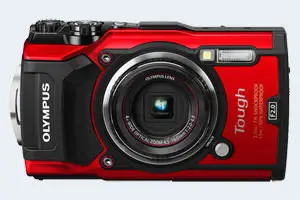Canon M100 vs Olympus TG-5
The Canon EOS M100 and the Olympus Tough TG-5 are two digital cameras that were officially introduced, respectively, in August 2017 and May 2017. The M100 is a mirrorless interchangeable lens camera, while the TG-5 is a fixed lens compact. The cameras are based on an APS-C (M100) and a 1/2.3-inch (TG-5) sensor. The Canon has a resolution of 24 megapixels, whereas the Olympus provides 12 MP.
Below is an overview of the main specs of the two cameras as a starting point for the comparison.

Check M100 offers at
ebay.com

Check TG-5 offers at
ebay.com
Going beyond this snapshot of core features and characteristics, what are the differences between the Canon EOS M100 and the Olympus Tough TG-5? Which one should you buy? Read on to find out how these two cameras compare with respect to their body size, their imaging sensors, their shooting features, their input-output connections, and their reception by expert reviewers.
Body comparison
An illustration of the physical size and weight of the Canon M100 and the Olympus TG-5 is provided in the side-by-side display below. The two cameras are presented according to their relative size. Three consecutive perspectives from the front, the top, and the back are available. All size dimensions are rounded to the nearest millimeter.
The M100 can be obtained in two different colors (black, white), while the TG-5 is also available in two color-versions, but different ones (black, red).
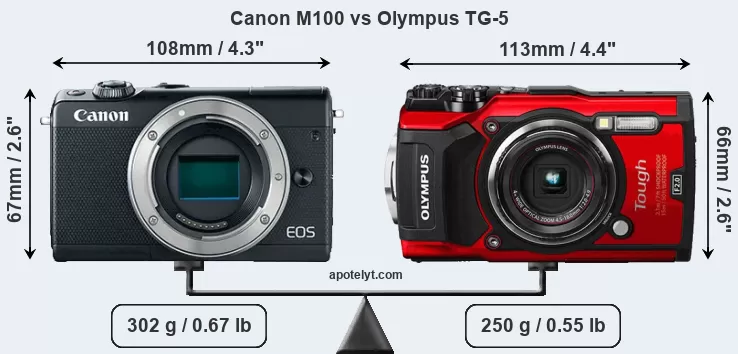

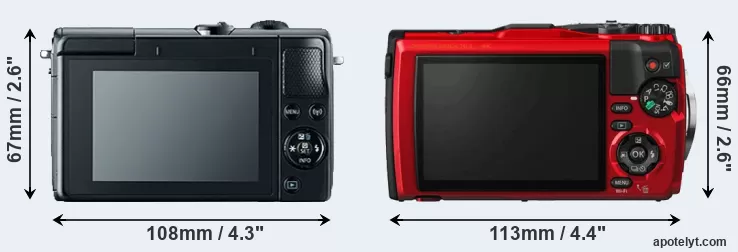
If the front view area (width x height) of the cameras is taken as an aggregate measure of their size, the Olympus TG-5 is somewhat larger (3 percent) than the Canon M100. It is noteworthy in this context that the TG-5 is splash and dust-proof, while the M100 does not feature any corresponding weather-sealing. More than that, the TG-5 is water-proof up to 15m and can, thus, be used for underwater photography.
The above size and weight comparisons are to some extent incomplete and possibly misleading, as the TG-5 has a lens built in, whereas the M100 is an interchangeable lens camera that requires a separate lens. Attaching the latter will add extra weight and bulk to the setup.
Concerning battery life, the M100 gets 295 shots out of its Canon LP-E12 battery, while the TG-5 can take 340 images on a single charge of its Olympus LI-92B power pack. The power pack in the TG-5 can be charged via the USB port, which can be very convenient when travelling.
The following table provides a synthesis of the main physical specifications of the two cameras and other similar ones. If you want to switch the focus of the display and review another camera pair, you can move across to the CAM-parator tool and choose from the broad selection of possible camera comparisons there.

| # | Camera Model |
Camera Width |
Camera Height |
Camera Depth |
Camera Weight |
Battery Life |
Weather Sealing |
Camera Launch |
Launch Price (USD) |
Street Price |
|
|---|---|---|---|---|---|---|---|---|---|---|---|
| 1. | Canon M100 | 108 mm | 67 mm | 35 mm | 302 g | 295 | n | Aug 2017 | 499 | ebay.com | |
| 2. | Olympus TG-5 | 113 mm | 66 mm | 32 mm | 250 g | 340 | Y | May 2017 | 449 | ebay.com | |
| 3. | Canon M200 | 108 mm | 67 mm | 35 mm | 299 g | 315 | n | Sep 2019 | 549 | ebay.com | |
| 4. | Canon M50 | 116 mm | 88 mm | 59 mm | 390 g | 235 | n | Feb 2018 | 779 | ebay.com | |
| 5. | Canon T7 | 129 mm | 101 mm | 78 mm | 475 g | 500 | n | Feb 2018 | 449 | amazon.com | |
| 6. | Canon G9 X Mark II | 98 mm | 58 mm | 31 mm | 206 g | 235 | n | Jan 2017 | 529 | ebay.com | |
| 7. | Canon M6 | 112 mm | 68 mm | 45 mm | 390 g | 295 | n | Feb 2017 | 779 | ebay.com | |
| 8. | Canon SL2 | 122 mm | 93 mm | 70 mm | 453 g | 650 | n | Jun 2017 | 549 | ebay.com | |
| 9. | Canon SX730 | 110 mm | 64 mm | 40 mm | 300 g | 250 | n | Apr 2017 | 399 | ebay.com | |
| 10. | Canon M5 | 116 mm | 89 mm | 61 mm | 427 g | 295 | n | Sep 2016 | 979 | ebay.com | |
| 11. | Canon M3 | 111 mm | 68 mm | 44 mm | 366 g | 250 | n | Feb 2015 | 679 | ebay.com | |
| 12. | Canon M10 | 108 mm | 67 mm | 35 mm | 301 g | 255 | n | Oct 2015 | 499 | ebay.com | |
| 13. | Canon M | 109 mm | 66 mm | 32 mm | 298 g | 230 | n | Jul 2012 | 599 | ebay.com | |
| 14. | Olympus TG-6 | 113 mm | 66 mm | 32 mm | 253 g | 340 | Y | May 2019 | 449 | ebay.com | |
| 15. | Olympus TG-4 | 112 mm | 66 mm | 31 mm | 247 g | 380 | Y | Apr 2015 | 379 | ebay.com | |
| 16. | Olympus XZ-1 | 111 mm | 65 mm | 42 mm | 275 g | 320 | n | Jan 2011 | 499 | ebay.com | |
| 17. | OM System TG-7 | 114 mm | 66 mm | 33 mm | 249 g | 330 | Y | Sep 2023 | 549 | amazon.com | |
| Note: Measurements and pricing do not include easily detachable parts, such as add-on or interchangeable lenses or optional viewfinders. | |||||||||||
Any camera decision will naturally be influenced heavily by the price. The manufacturer’s suggested retail prices give an idea on the placement of the camera in the maker’s lineup and the broader market. The TG-5 was launched at a lower price than the M100, despite having a lens built in. Usually, retail prices stay at first close to the launch price, but after several months, discounts become available. Later in the product cycle and, in particular, when the replacement model is about to appear, further discounting and stock clearance sales often push the camera price considerably down. Then, after the new model is out, very good deals can frequently be found on the pre-owned market.
Sensor comparison
The imaging sensor is at the core of digital cameras and its size is one of the main determining factors of image quality. A large sensor will tend to have larger individual pixels that provide better low-light sensitivity, wider dynamic range, and richer color-depth than smaller pixel-units in a sensor of the same technological generation. Moreover, a large sensor camera will give the photographer more control over depth-of-field in the image and, thus, the ability to better isolate a subject from the background. On the downside, larger sensors tend to be associated with larger, more expensive camera bodies and lenses.
Of the two cameras under consideration, the Canon M100 features an APS-C sensor and the Olympus TG-5 a 1/2.3-inch sensor. The sensor area in the TG-5 is 92 percent smaller. As a result of these sensor size differences, the cameras have a format factor of, respectively, 1.6 and 5.6. The sensor in the M100 has a native 3:2 aspect ratio, while the one in the TG-5 offers a 4:3 aspect.
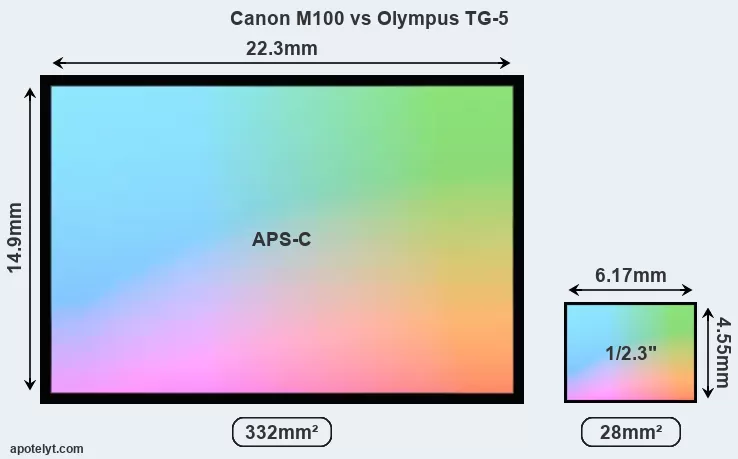
With 24MP, the M100 offers a higher resolution than the TG-5 (12MP), but the M100 nevertheless has larger individual pixels (pixel pitch of 3.72μm versus 1.53μm for the TG-5) due to its larger sensor. Moreover, the M100 is a somewhat more recent model (by 3 months) than the TG-5, and its sensor might have benefitted from technological advances during this time that further enhance the light gathering capacity of its pixels.
The resolution advantage of the Canon M100 implies greater flexibility for cropping images or the possibility to print larger pictures. The maximum print size of the M100 for good quality output (200 dots per inch) amounts to 30 x 20 inches or 76.2 x 50.8 cm, for very good quality (250 dpi) 24 x 16 inches or 61 x 40.6 cm, and for excellent quality (300 dpi) 20 x 13.3 inches or 50.8 x 33.9 cm. The corresponding values for the Olympus TG-5 are 20 x 15 inches or 50.8 x 38.1 cm for good quality, 16 x 12 inches or 40.6 x 30.5 cm for very good quality, and 13.3 x 10 inches or 33.9 x 25.4 cm for excellent quality prints.
The M100 has on-sensor phase detect pixels, which results in fast and reliable autofocus acquisition even during live view operation.
The Canon EOS M100 has a native sensitivity range from ISO 100 to ISO 25600. The corresponding ISO settings for the Olympus Tough TG-5 are ISO 100 to ISO 12800 (no boost).
In terms of underlying technology, the M100 is build around a CMOS sensor, while the TG-5 uses a BSI-CMOS imager. Both cameras use a Bayer filter for capturing RGB colors on a square grid of photosensors. This arrangement is found in most digital cameras.
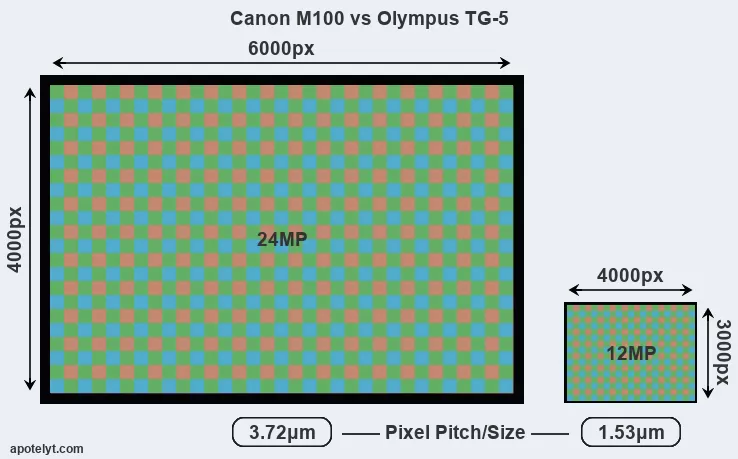
For many cameras, data on sensor performance has been reported by DXO Mark. This service determines an overall sensor rating, as well as sub-scores for low-light sensitivity ("DXO Sports"), dynamic range ("DXO Landscape"), and color depth ("DXO Portrait"). The table below summarizes the physical sensor characteristics and sensor quality findings and compares them across a set of similar cameras.

| # | Camera Model |
Sensor Class |
Resolution (MP) |
Horiz. Pixels |
Vert. Pixels |
Video Format |
DXO Portrait |
DXO Landscape |
DXO Sports |
DXO Overall |
|
|---|---|---|---|---|---|---|---|---|---|---|---|
| 1. | Canon M100 | APS-C | 24.0 | 6000 | 4000 | 1080/60p | 23.5 | 12.9 | 1272 | 78 | |
| 2. | Olympus TG-5 | 1/2.3 | 12.0 | 4000 | 3000 | 4K/30p | 20.5 | 11.9 | 934 | 50 | |
| 3. | Canon M200 | APS-C | 24.0 | 6000 | 4000 | 4k/25p | 24.0 | 13.5 | 1836 | 82 | |
| 4. | Canon M50 | APS-C | 24.0 | 6000 | 4000 | 4K/24p | 23.8 | 13.3 | 1684 | 81 | |
| 5. | Canon T7 | APS-C | 24.0 | 6000 | 4000 | 1080/30p | 23.8 | 13.3 | 1684 | 81 | |
| 6. | Canon G9 X Mark II | 1-inch | 20.0 | 5472 | 3648 | 1080/60p | 21.9 | 12.5 | 522 | 65 | |
| 7. | Canon M6 | APS-C | 24.0 | 6000 | 4000 | 1080/60p | 23.4 | 12.6 | 1317 | 78 | |
| 8. | Canon SL2 | APS-C | 24.0 | 6000 | 4000 | 1080/60p | 23.6 | 13.4 | 1041 | 79 | |
| 9. | Canon SX730 | 1/2.3 | 20.2 | 5184 | 3888 | 1080/60p | 20.5 | 11.9 | 924 | 50 | |
| 10. | Canon M5 | APS-C | 24.0 | 6000 | 4000 | 1080/60p | 23.4 | 12.4 | 1262 | 77 | |
| 11. | Canon M3 | APS-C | 24.0 | 6000 | 4000 | 1080/30p | 22.8 | 11.8 | 1169 | 72 | |
| 12. | Canon M10 | APS-C | 17.9 | 5184 | 3456 | 1080/30p | 22.2 | 11.4 | 753 | 65 | |
| 13. | Canon M | APS-C | 17.9 | 5184 | 3456 | 1080/30p | 22.1 | 11.2 | 827 | 65 | |
| 14. | Olympus TG-6 | 1/2.3 | 12.0 | 4000 | 3000 | 4K/30p | 20.7 | 12.2 | 1127 | 52 | |
| 15. | Olympus TG-4 | 1/2.3 | 15.9 | 4608 | 3456 | 1080/30p | 20.2 | 11.6 | 737 | 47 | |
| 16. | Olympus XZ-1 | 1/1.7 | 10.1 | 3664 | 2752 | 720/30p | 18.8 | 10.4 | 117 | 34 | |
| 17. | OM System TG-7 | 1/2.3 | 12.0 | 4000 | 3000 | 4K/30p | 20.9 | 12.7 | 1553 | 54 | |
| Note: DXO values in italics represent estimates based on sensor size and age. | |||||||||||
Many modern cameras are not only capable of taking still images, but can also record movies. Both cameras under consideration are equipped with sensors that have a sufficiently high read-out speed for moving images, but the TG-5 provides a better video resolution than the M100. It can shoot movie footage at 4K/30p, while the Canon is limited to 1080/60p.
Feature comparison
Apart from body and sensor, cameras can and do differ across a range of features. The M100 and the TG-5 are similar in the sense that neither of the two has a viewfinder. The images are, thus, framed using live view on the rear LCD. The adjacent table lists some of the other core features of the Canon M100 and Olympus TG-5 along with similar information for a selection of comparators.

| # | Camera Model |
Viewfinder (Type or 000 dots) |
Control Panel (yes/no) |
LCD Specifications (inch/000 dots) |
LCD Attach- ment |
Touch Screen (yes/no) |
Max Shutter Speed * |
Max Shutter Flaps * |
Built-in Flash (yes/no) |
Built-in Image Stab |
|
|---|---|---|---|---|---|---|---|---|---|---|---|
| 1. | Canon M100 | none | n | 3.0 / 1040 | tilting | Y | 1/4000s | 6.1/s | Y | n | |
| 2. | Olympus TG-5 | none | n | 3.0 / 460 | fixed | n | 1/2000s | 20.0/s | Y | Y | |
| 3. | Canon M200 | none | n | 3.0 / 1040 | tilting | Y | 1/4000s | 6.1/s | Y | n | |
| 4. | Canon M50 | 2360 | n | 3.0 / 1040 | swivel | Y | 1/4000s | 10.0/s | Y | n | |
| 5. | Canon T7 | optical | n | 3.0 / 920 | fixed | n | 1/4000s | 3.0/s | Y | n | |
| 6. | Canon G9 X Mark II | none | n | 3.0 / 1040 | fixed | Y | 1/2000s | 8.2/s | Y | Y | |
| 7. | Canon M6 | optional | n | 3.0 / 1040 | tilting | Y | 1/4000s | 9.0/s | Y | n | |
| 8. | Canon SL2 | optical | n | 3.0 / 1040 | swivel | Y | 1/4000s | 5.0/s | Y | n | |
| 9. | Canon SX730 | none | n | 3.0 / 922 | tilting | n | 1/3200s | 5.9/s | Y | Y | |
| 10. | Canon M5 | 2360 | n | 3.2 / 1620 | tilting | Y | 1/4000s | 9.0/s | Y | n | |
| 11. | Canon M3 | optional | n | 3.0 / 1040 | tilting | Y | 1/4000s | 4.2/s | Y | n | |
| 12. | Canon M10 | none | n | 3.0 / 1040 | tilting | Y | 1/4000s | 4.6/s | Y | n | |
| 13. | Canon M | none | n | 3.0 / 1040 | fixed | Y | 1/4000s | 4.3/s | n | n | |
| 14. | Olympus TG-6 | none | n | 3.0 / 1040 | fixed | n | 1/2000s | 20.0/s | Y | Y | |
| 15. | Olympus TG-4 | none | n | 3.0 / 460 | fixed | n | 1/2000s | 5.0/s | Y | Y | |
| 16. | Olympus XZ-1 | optional | n | 3.0 / 614 | fixed | n | 1/2000s | 2.0/s | Y | Y | |
| 17. | OM System TG-7 | none | n | 3.0 / 1040 | fixed | n | 1/2000s | 20.0/s | Y | Y | |
| Note: *) Information refers to the mechanical shutter, unless the camera only has an electronic one. | |||||||||||
One differentiating feature between the two cameras concerns the touch sensitivity of the rear screen. The M100 has a touchscreen, while the TG-5 has a conventional panel. Touch control can be particularly helpful, for example, for setting the focus point.
The M100 has an articulated LCD that can be turned to be front-facing. This characteristic will be appreciated by vloggers and photographers who are interested in snapping selfies. In contrast, the TG-5 does not have a selfie-screen.The Olympus TG-5 has an intervalometer built-in. This enables the photographer to capture time lapse sequences, such as flower blooming, a sunset or moon rise, without purchasing an external camera trigger and related software.
Concerning the storage of imaging data, both the M100 and the TG-5 write their files to SDXC cards. Both cameras can use UHS-I cards, which provide for Ultra High Speed data transfer of up to 104 MB/s.
Connectivity comparison
For some imaging applications, the extent to which a camera can communicate with its environment can be an important aspect in the camera decision process. The table below provides an overview of the connectivity of the Canon EOS M100 and Olympus Tough TG-5 and, in particular, the interfaces the cameras (and selected comparators) provide for accessory control and data transfer.

| # | Camera Model |
Hotshoe Port |
Internal Mic / Speaker |
Microphone Port |
Headphone Port |
HDMI Port |
USB Port |
WiFi Support |
NFC Support |
Bluetooth Support |
|
|---|---|---|---|---|---|---|---|---|---|---|---|
| 1. | Canon M100 | - | stereo / mono | - | - | micro | 2.0 | Y | Y | Y | |
| 2. | Olympus TG-5 | - | stereo / mono | - | - | micro | 2.0 | Y | - | - | |
| 3. | Canon M200 | - | stereo / mono | - | - | micro | 2.0 | Y | - | Y | |
| 4. | Canon M50 | Y | stereo / mono | Y | - | micro | 2.0 | Y | - | Y | |
| 5. | Canon T7 | Y | mono / mono | - | - | mini | 2.0 | Y | Y | - | |
| 6. | Canon G9 X Mark II | - | stereo / mono | - | - | micro | 2.0 | Y | Y | Y | |
| 7. | Canon M6 | Y | stereo / mono | Y | - | mini | 2.0 | Y | Y | Y | |
| 8. | Canon SL2 | Y | stereo / mono | Y | - | mini | 2.0 | Y | Y | Y | |
| 9. | Canon SX730 | - | stereo / mono | - | - | micro | 2.0 | Y | Y | Y | |
| 10. | Canon M5 | Y | stereo / mono | Y | - | mini | 2.0 | Y | Y | Y | |
| 11. | Canon M3 | Y | stereo / mono | Y | - | mini | 2.0 | Y | Y | - | |
| 12. | Canon M10 | - | stereo / mono | - | - | mini | 2.0 | Y | Y | - | |
| 13. | Canon M | Y | stereo / mono | Y | - | mini | 2.0 | - | - | - | |
| 14. | Olympus TG-6 | - | stereo / mono | - | - | micro | 2.0 | Y | - | - | |
| 15. | Olympus TG-4 | - | stereo / mono | - | - | micro | 2.0 | Y | - | - | |
| 16. | Olympus XZ-1 | Y | mono / - | - | - | mini | 2.0 | - | - | - | |
| 17. | OM System TG-7 | - | stereo / mono | - | - | micro | 2.0 | Y | - | - |
Travel and landscape photographers will find it useful that the TG-5 has an internal geolocalization sensor and can record GPS coordinates in its EXIF data.
Both the M100 and the TG-5 have been discontinued, but can regularly be found used on ebay. The TG-5 was replaced by the Olympus TG-6, while the M100 was followed by the Canon M200. Further information on the features and operation of the M100 and TG-5 can be found, respectively, in the Canon M100 Manual (free pdf) or the online Olympus TG-5 Manual.
Review summary
So what is the bottom line? Is the Canon M100 better than the Olympus TG-5 or vice versa? Below is a summary of the relative strengths of each of the two contestants.

Arguments in favor of the Canon EOS M100:
- More detail: Offers more megapixels (24 vs 12MP) with a 44% higher linear resolution.
- Better image quality: Features bigger pixels on a larger sensor for higher quality imaging.
- Richer colors: The pixel size advantage translates into images with better, more accurate colors.
- More dynamic range: Larger pixels capture a wider spectrum of light and dark details.
- Better low-light sensitivity: Larger pixels means good image quality even under poor lighting.
- Better live-view autofocus: Features on-sensor phase-detection for more confident autofocus.
- More detailed LCD: Has a higher resolution rear screen (1040k vs 460k dots).
- More flexible LCD: Has a tilting screen for odd-angle shots in landscape orientation.
- Fewer buttons to press: Is equipped with a touch-sensitive rear screen to facilitate handling.
- More selfie-friendly: Has an articulated screen that can be turned to be front-facing.
- Faster shutter: Has higher mechanical shutter speed (1/4000s vs 1/2000s) to freeze action.
- More flexible: Accepts interchangeable lenses, so that lens characteristics can be altered.
- Easier device pairing: Supports NFC for fast wireless image transfer over short distances.
- Easier wireless transfer: Supports Bluetooth for image sharing without cables.
- More modern: Is somewhat more recent (announced 3 months after the TG-5).

Advantages of the Olympus Tough TG-5:
- Better video: Provides higher definition movie capture (4K/30p vs 1080/60p).
- Faster burst: Shoots at higher frequency (20 vs 6.1 flaps/sec) to capture the decisive moment.
- Easier time-lapse photography: Has an intervalometer built-in for low frequency shooting.
- Ready to shoot: Has an integrated lens, whereas the M100 necessitates an extra lens.
- Less heavy: Has a lower weight even though it has a lens built in (unlike the M100).
- Longer lasting: Gets more shots (340 versus 295) out of a single battery charge.
- Easier travel charging: Can be conveniently charged via its USB port.
- Better sealing: Is splash and dust sealed for shooting in inclement weather conditions.
- Sharper images: Has stabilization technology built-in to reduce the impact of hand-shake.
- Water-proof: Is rugged and sealed and can thus be used for underwater photography (up to 15m).
- Easier geotagging: Features an internal GPS sensor to log localization data.
- More affordable: Was introduced at a lower price, despite coming with a built-in lens.
- More heavily discounted: Has been on the market for longer (launched in May 2017).
If the number of relative strengths (bullet points above) is taken as a guide, the M100 emerges as the winner of the contest (15 : 13 points). However, the relative importance of the various individual camera aspects will vary according to personal preferences and needs, so that you might like to apply corresponding weights to the particular features before making a decision on a new camera. A professional wildlife photographer will view the differences between cameras in a way that diverges from the perspective of a family photog, and a person interested in architecture has distinct needs from a sports shooter. Hence, the decision which camera is best and worth buying is often a very personal one.
How about other alternatives? Do the specifications of the Canon M100 and the Olympus TG-5 place the cameras among the top in their class? Find out in the latest Best Mirrorless Interchangeable Lens Camera and Best Travel-Zoom Camera listings whether the two cameras rank among the cream of the crop.
In any case, while the specs-based evaluation of cameras can be instructive in revealing their potential as photographic tools, it remains incomplete and does no justice, for example, to the way the M100 or the TG-5 perform in practice. User reviews, such as those found at amazon, can sometimes inform about these issues, but such feedback is often incomplete, inconsistent, and biased.
Expert reviews
This is why expert reviews are important. The table below provides a synthesis of the camera assessments of some of the best known photo-gear review sites (amateurphotographer [AP], cameralabs [CL], digitalcameraworld [DCW], dpreview [DPR], ephotozine [EPZ], photographyblog [PB]). As can be seen, the professional reviewers agree in many cases on the quality of different cameras, but sometimes their assessments diverge, reinforcing the earlier point that a camera decision is often a very personal choice.

| # | Camera Model |
AP score |
CL score |
DCW score |
DPR score |
EPZ score |
PB score |
Camera Launch |
Launch Price (USD) |
Street Price |
|
|---|---|---|---|---|---|---|---|---|---|---|---|
| 1. | Canon M100 | 3/5 | + | .. | .. | 4/5 | 3.5/5 | Aug 2017 | 499 | ebay.com | |
| 2. | Olympus TG-5 | .. | + + | 4.5/5 | .. | 4/5 | 4/5 | May 2017 | 449 | ebay.com | |
| 3. | Canon M200 | .. | + | 3/5 | 79/100 | 4/5 | 4/5 | Sep 2019 | 549 | ebay.com | |
| 4. | Canon M50 | .. | + | 4/5 | 79/100 | .. | 3.5/5 | Feb 2018 | 779 | ebay.com | |
| 5. | Canon T7 | .. | o | 3.5/5 | .. | 3.5/5 | 3.5/5 | Feb 2018 | 449 | amazon.com | |
| 6. | Canon G9 X Mark II | 4/5 | .. | 4/5 | 75/100 | 4.5/5 | 4.5/5 | Jan 2017 | 529 | ebay.com | |
| 7. | Canon M6 | .. | .. | .. | 80/100 | 4/5 | 4/5 | Feb 2017 | 779 | ebay.com | |
| 8. | Canon SL2 | 4/5 | + + | 4/5 | 78/100 | 4.5/5 | 4.5/5 | Jun 2017 | 549 | ebay.com | |
| 9. | Canon SX730 | .. | + | .. | .. | 4/5 | 4/5 | Apr 2017 | 399 | ebay.com | |
| 10. | Canon M5 | 4/5 | + | 4/5 | 82/100 | 4/5 | 4/5 | Sep 2016 | 979 | ebay.com | |
| 11. | Canon M3 | 4/5 | o | .. | 75/100 | 4.5/5 | 4/5 | Feb 2015 | 679 | ebay.com | |
| 12. | Canon M10 | .. | .. | .. | .. | .. | 4/5 | Oct 2015 | 499 | ebay.com | |
| 13. | Canon M | 3/5 | + | .. | .. | 4/5 | 4/5 | Jul 2012 | 599 | ebay.com | |
| 14. | Olympus TG-6 | 4/5 | + + | 4.5/5 | 76/100 | 4/5 | 4/5 | May 2019 | 449 | ebay.com | |
| 15. | Olympus TG-4 | .. | + | .. | 79/100 | 4/5 | 4/5 | Apr 2015 | 379 | ebay.com | |
| 16. | Olympus XZ-1 | 4/5 | .. | .. | 74/100 | 4.5/5 | 4.5/5 | Jan 2011 | 499 | ebay.com | |
| 17. | OM System TG-7 | 4/5 | .. | 4.5/5 | .. | 4/5 | 4/5 | Sep 2023 | 549 | amazon.com | |
| Note: (+ +) highly recommended; (+) recommended; (o) reviewed; (..) not available. | |||||||||||
The review scores listed above should be treated with care, though. The ratings were established in reference to similarly priced cameras that were available in the market at the time of the review. A score, therefore, has to be seen in close connection to the price and market introduction time of the camera, and comparing ratings of very distinct cameras or ones that are far apart in terms of their release date have little meaning. Also, please note that some of the review sites have changed their methodology and reporting over time.

Check M100 offers at
ebay.com

Check TG-5 offers at
ebay.com
Other camera comparisons
Did this review help to inform your camera decision process? If you would like to see a different side-by-side camera review, just make a corresponding selection in the search boxes below. As an alternative, you can also directly jump to any one of the listed comparisons that were previously generated by the CAM-parator tool.
- Canon 50D vs Olympus TG-5
- Canon 750D vs Canon M100
- Canon G9 X vs Canon M100
- Canon M100 vs Fujifilm GFX 100S
- Canon M100 vs Fujifilm XP140
- Canon M100 vs Nikon W300
- Canon M100 vs Panasonic ZS80
- Canon T4i vs Olympus TG-5
- Leica T vs Olympus TG-5
- Nikon Z30 vs Olympus TG-5
- Olympus TG-5 vs Sony A900
- Olympus TG-5 vs Sony HX80
Specifications: Canon M100 vs Olympus TG-5
Below is a side-by-side comparison of the specs of the two cameras to facilitate a quick review of their differences and common features.
| Camera Model | Canon M100 | Olympus TG-5 |
|---|---|---|
| Camera Type | Mirrorless system camera | Fixed lens compact camera |
| Camera Lens | Canon EF-M mount lenses | 25-100mm f/2.0-4.9 |
| Launch Date | August 2017 | May 2017 |
| Launch Price | USD 499 | USD 449 |
| Sensor Specs | Canon M100 | Olympus TG-5 |
| Sensor Technology | CMOS | BSI-CMOS |
| Sensor Format | APS-C Sensor | 1/2.3" Sensor |
| Sensor Size | 22.3 x 14.9 mm | 6.17 x 4.55 mm |
| Sensor Area | 332.27 mm2 | 28.0735 mm2 |
| Sensor Diagonal | 26.8 mm | 7.7 mm |
| Crop Factor | 1.6x | 5.6x |
| Sensor Resolution | 24 Megapixels | 12 Megapixels |
| Image Resolution | 6000 x 4000 pixels | 4000 x 3000 pixels |
| Pixel Pitch | 3.72 μm | 1.53 μm |
| Pixel Density | 7.22 MP/cm2 | 42.74 MP/cm2 |
| Moiré control | Anti-Alias filter | Anti-Alias filter |
| Movie Capability | 1080/60p Video | 4K/30p Video |
| ISO Setting | 100 - 25,600 ISO | 100 - 12,800 ISO |
| Image Processor | DIGIC 7 | TruePic VIII |
| DXO Sensor Quality (score) | 78 | .. |
| DXO Color Depth (bits) | 23.5 | .. |
| DXO Dynamic Range (EV) | 12.9 | .. |
| DXO Low Light (ISO) | 1272 | .. |
| Screen Specs | Canon M100 | Olympus TG-5 |
| Viewfinder Type | no viewfinder | no viewfinder |
| LCD Framing | Live View | Live View |
| Rear LCD Size | 3.0inch | 3.0inch |
| LCD Resolution | 1040k dots | 460k dots |
| LCD Attachment | Tilting screen | Fixed screen |
| Touch Input | Touchscreen | no Touchscreen |
| Shooting Specs | Canon M100 | Olympus TG-5 |
| Focus System | On-Sensor Phase-detect | Contrast-detect AF |
| Manual Focusing Aid | Focus Peaking | Focus Peaking |
| Max Shutter Speed (mechanical) | 1/4000s | 1/2000s |
| Continuous Shooting | 6.1 shutter flaps/s | 20 shutter flaps/s |
| Time-Lapse Photography | no Intervalometer | Intervalometer built-in |
| Image Stabilization | Lens stabilization only | In-body stabilization |
| Fill Flash | Built-in Flash | Built-in Flash |
| Storage Medium | SDXC cards | SDXC cards |
| Single or Dual Card Slots | Single card slot | Single card slot |
| UHS card support | UHS-I | UHS-I |
| Connectivity Specs | Canon M100 | Olympus TG-5 |
| External Flash | no Hotshoe | no Hotshoe |
| USB Connector | USB 2.0 | USB 2.0 |
| HDMI Port | micro HDMI | micro HDMI |
| Wifi Support | Wifi built-in | Wifi built-in |
| Near-Field Communication | NFC built-in | no NFC |
| Bluetooth Support | Bluetooth built-in | no Bluetooth |
| Geotagging | no internal GPS | GPS built-in |
| Body Specs | Canon M100 | Olympus TG-5 |
| Environmental Sealing | not weather sealed | Waterproof body (15m) |
| Battery Type | Canon LP-E12 | Olympus LI-92B |
| Battery Life (CIPA) | 295 shots per charge | 340 shots per charge |
| In-Camera Charging | no USB charging | USB charging |
| Body Dimensions |
108 x 67 x 35 mm (4.3 x 2.6 x 1.4 in) |
113 x 66 x 32 mm (4.4 x 2.6 x 1.3 in) |
| Camera Weight | 302 g (10.7 oz) | 250 g (8.8 oz) |

Check M100 offers at
ebay.com

Check TG-5 offers at
ebay.com
Did you notice an error on this page? If so, please get in touch, so that we can correct the information.

